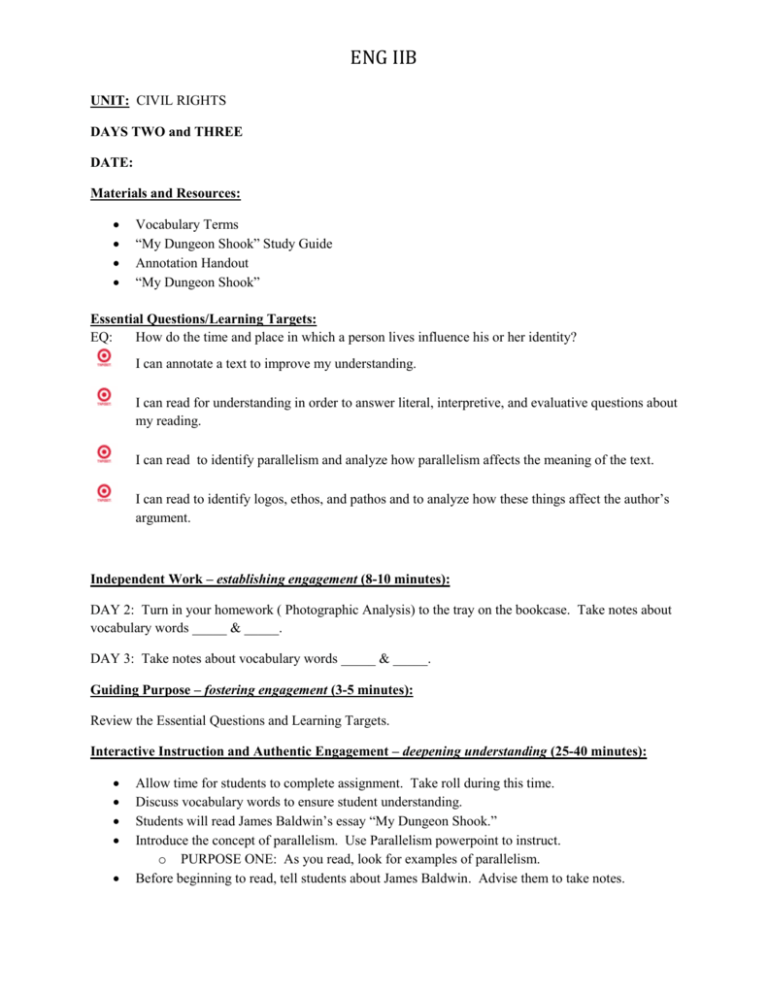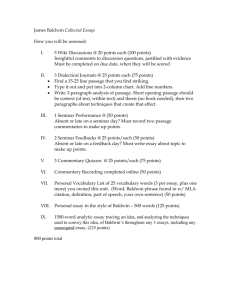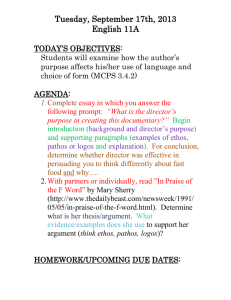DAY 2 & 3
advertisement

ENG IIB UNIT: CIVIL RIGHTS DAYS TWO and THREE DATE: Materials and Resources: Vocabulary Terms “My Dungeon Shook” Study Guide Annotation Handout “My Dungeon Shook” Essential Questions/Learning Targets: EQ: How do the time and place in which a person lives influence his or her identity? I can annotate a text to improve my understanding. I can read for understanding in order to answer literal, interpretive, and evaluative questions about my reading. I can read to identify parallelism and analyze how parallelism affects the meaning of the text. I can read to identify logos, ethos, and pathos and to analyze how these things affect the author’s argument. Independent Work – establishing engagement (8-10 minutes): DAY 2: Turn in your homework ( Photographic Analysis) to the tray on the bookcase. Take notes about vocabulary words _____ & _____. DAY 3: Take notes about vocabulary words _____ & _____. Guiding Purpose – fostering engagement (3-5 minutes): Review the Essential Questions and Learning Targets. Interactive Instruction and Authentic Engagement – deepening understanding (25-40 minutes): Allow time for students to complete assignment. Take roll during this time. Discuss vocabulary words to ensure student understanding. Students will read James Baldwin’s essay “My Dungeon Shook.” Introduce the concept of parallelism. Use Parallelism powerpoint to instruct. o PURPOSE ONE: As you read, look for examples of parallelism. Before beginning to read, tell students about James Baldwin. Advise them to take notes. ENG IIB His father was a minister (which is what Baldwin means in “My Dungeon Shook” when he describes his father as being “holy.”) o He lived in Europe for most of the 1950s. o He learned much about writing from Richard Wright who was an AfricanAmericanauthor of sometimes controversial novels, short stories, poems, and non-fiction. Much of his literature concerns racial themes, especially those involving the plight of African-Americans during the late 19th to mid-20th centuries. His work helped redefine discussions of race relations in America in the mid-20th century. o He wrote novels such as Go Tell it On the Mountain and If Beale Street Could Talk. o His essays are some of the greatest American essays written in the twentieth century; they often deal with issures of race, identity, and African American rights. “My Dungeon Shook” was published at the height of the civil rights movement in 1962, five years after the photo of Elizabeth Eckford was taken. Baldwin wrote the essay on the 100th anniversary of Abraham Lincoln’s signing of the Emancipation Procoamation. o PURPOSE 2: As you read, think about why Baldwin wrote the essay on that anniversary. This essay is written as a letter from an African American man to his nephew. The essay is both personal and political, meant to be read not only by Baldwin’s nephew, but also by a wider public. o PURPOSE 3: As you read, think about the photo of Elizabeth Eckford trying to integrate Little Rock Central High School. Hand out the “My Dungeon Shook” Study Guide. Students should use these questions to guide their reading. Go over the terms literal, interpretive, and evaluative. Take notes. Label “Types of Questions” o Literal – the answer can be found directly in the text o Interpretive - An interpretive question asks that you interpret the text: Take what you know from the text and give it meaning through your own inferences (educated guesses) Answers cannot be found DIRECTLY in the text alone! o Evaluative - Evaluative questions deal with judgment, value and choice. Ask you to make and defend judgments and choices: What do you think about…? What is your opinion on…? Distribute Annotation Handout and Rubric. Discuss annotation. Advise students to look at the rubric. Mark the text as you read. The text, along with annotations will be taken up and scored. This process is an expected part of this class which will be practiced with each reading. Advise students that they will probably need to read the piece more than once, especially portions of the essay that are particularly troubling or confusing. Allow time for reading and completion of annotations/study guide. Discuss as a class, after students have had time to complete reading and work. o Help students to see that this essay was constructed for a purpose. o Help students to see the essay as an argument in the context of the Civil RightsMovement. o “Please try to be clear, dear James, through the strom which rages about your youthful head today, about the reality which lies behind the words acceptance and integration,” for o ENG IIB example. How does this relate to the Civil rights Movement? It refers to the social and political turmoil that was gripping the US at the time. o Talk about all of the questions on the study guide. o What other issues does the essay raise? o Relate to the essay to the students’ own experiences. In what way might your country’s attitude toward you or your people affect your sense of identity? o Why is the word integration such an important part of this essay? o What is Baldwin saying about the relationship of white people to African Americans? o Why does Baldwin think “The country is celebrating one hundred years of freedom one hundred years too soon. We cannot be free until they are free”? o To whom does they refer in the closing sentence? Read part of the essay aloud, not for purposes of analysis, but to help students hear how Baldwin’s use of parallelism – and the consequent rhythm of his sentences – contributes to the power of his argument. Use paragraph two where Baldwin mentions how long he has known his brother: “Let him laugh and I see a cellar . . . Let him curse and I remember him . . . .” Ask students to rewrite these sentences in a nonparallel structure. o How could the feeling evoked by these sentences be changed by the change in structure? Discuss how parallelism can change the meaning of student writing. Introduce the concepts of logos, ethos, and pathos. Use the prefixes eth-, log-, and path- to help students understand the meaning of these terms. Create a chart together for each to record the definitions of each term and a list of things authors may use in each category. Use Logos, Ethos, Pathos Chart to guide student response. o Logos – logical appeal – facts, numbers, statistics o Pathos – emotional appeal – anecdotes, figurative language, allusions o Ethos- author credibility – credible sources, logos, allusions, diction, etc. Revisit “My Dungeon Shook.” Distribute three different color highlighters to each student. Use a different color to mark the text for evidence of logos, ethos, and pathos used by Baldwin. Allow time for this process. Break students into pairs to discuss what they came up with. Discuss as a class. Analyze the text discussing how Baldwin establishes his credibility, how he appeals to emotions and where he uses logical or structural arguments to make his case. Discuss piece in relation to appropriate vocabulary students have learned to date. Closure and Consolidation – making meaning, clarify (5-10 minures): Take up annotations, scoring using rubric. Make notes regarding logos, ethos, and pathos. Record score as participation grade and return to students as feedback for future assessment.







